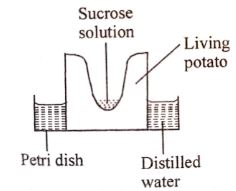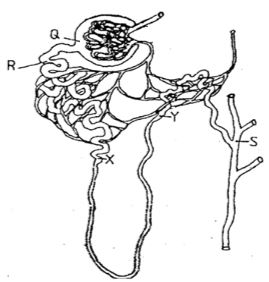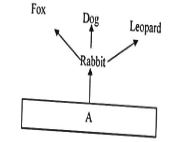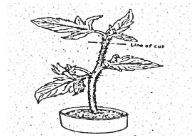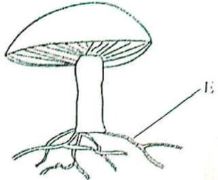Instructions
- Answer all the questions
-
- Students at Ikumbi high school observed that when sodium chloride was poured onto grass, the grass dried up. Explain this observation. (2mks)
- Study the experimental setup below and answer the questions that follow:
- Name the process that is being investigated (1mk)
- State and explain what would be observed if the setup was left for 12 hours (3mks)
-
- Name the blood vessel that connects arteries to vein. (1mark)
- Explain two ways in which the vessel named in (a) above are adapted to carry out their functions (2 marks)
- How does hot water of about 35°C act as a pollutant when it is discharged from industries into rivers? (2mks)
- Name the causative agents of the following diseases in humans. (2mks)
- Amoebic dysentery.
- Candidiasis.
-
- Define the term immunity. (1mk)
- Distinguish between natural immunity and acquired immunity. (1mk)
- Identify one immunizable disease in Kenya. (1mk)
- Give two advantages of polyploidy in plants. (2mks).
- The diagram below illustrates part of a nephron from a mammalian kidney.
- Name the fluid found in the part labeled Q. (1mk)
- Identify the process responsible for the formation of the fluid named in (a) above. (1mk)
- Which two hormones exert their effect in the nephron? (2mks)
- Explain how blood sugar level is maintained constant in human blood (3mks)
- State three unique characteristics of members of the class Crustacea. (3mks)
- How is mammalian skin adapted for excretion (3mks)
- The paddles of whales and the fins of fish adapt these organisms to aquatic habitats.
- Name the evolutionary process that may have given rise to these structures. (1mk)
- What is the name given to such structures? (1mk)
- The diagram below show part of a food relationship in an ecosystem
- Name the food relationship shown in the diagram (1mk)
- Name the trophic level occupied by organism A (1mk)
- What is the main source of energy in the ecosystem shown in the diagram above (1mk)
-
- Name a protein and vitamin involved in blood clotting.
- Protein. (1mk)
- Vitamin (1mk)
- Explain why blood from a donor whose blood group is A cannot be transfused into the recipient whose blood group is B. (2mks)
- Name a protein and vitamin involved in blood clotting.
-
- State two effects of Gibberellins on shoots of plants. (2mks)
- Account for loss in dry weight of cotyledons in a germinating bean seed. (1mk).
- Explain why a pregnant woman excretes less urea compared to a woman who is non pregnant. (2mks)
- Study the reaction below and answer the questions that follow.
- What biological processes are represented by A and B? (2mks)
- Identify the product Y. (1mk)
- State the bond represented by X. (1mk)
- What biological processes are represented by A and B? (2mks)
- Explain what happens during the light stage of photosynthesis. (3mks)
- State two characteristics of aerenchyma tissue. (2mks).
-
- Name the substance that accumulates in muscles when respiration occurs with insufficient oxygen. (1mk)
- Give the end products of anaerobic respiration in plants. (2mks).
- What is the importance of carrying out the following procedures when preparing temporary slides in the laboratory? (3mks).
- Adding water to the specimen.
- Staining the specimen.
- State two functions of the body tube of a light microscope (2marks)
- In an experiment the shoot tip of a young tomato plant was decapitated as shown in the diagram below
- State the expected results after 2 weeks (1mk)
- Give a reason for your answer in (a) above (2mks)
- Name two internal factors that are necessary for seed germination. (2mks)
- Certain animals have the following dental formula
A; i 3/3, c 1/1, pm 4/4, m 2/3 B. i 0/3 , c 0/1 , pm 2/2 , m 3/3- What is the most likely mode of feeding for animals A and B.? (2mks)
- Give a reason for your answer in (i) above. (1mk)
- Name the components of a DNA molecule. (3mks)
- Name the characteristics of living organisms shown by each of the following;
- Budding in yeast (1mark)
- Enlargement of the eye pupil in dim light (1mark)
- The diagram below shows an organism in a certain kingdom
- Name kingdom to which the organism belongs (1mk)
- State the mode of nutrition for the organism (1mk)
- Name the part labeled E and state two of its functions (3mk)
Name……………………
Functions:
MARKING SCHEME
-
- Students at Ikumbi high school observed that when sodium chloride was poured onto grass ,the grass dried up. Explain this this observation. (2mks)
- The external environment becomes hypertonic compared to the internal tissues of the leaves ;the leaves looses water by osmosis making them unable to carry out vital biological processes such as photosynthesis(hence dry up)
- osmosis
- Level of the liquid in the cavity of the potato while that in the petri dish will drop b ecause cells adjacent to the sugar solution will loose water into the solution by osmosis
- Students at Ikumbi high school observed that when sodium chloride was poured onto grass ,the grass dried up. Explain this this observation. (2mks)
-
- Name the blood vessel that connects arteries to vein. (1mk)
- Cappilaries
- Explain three ways in which the vessel named in (a) above are adapted to carry out their functions. (3mks)
- Numerous to increase the surface area over which diffusion and active transport of substances occur
- Thin walled/one cell thick to reduce distance over which exchange of substances occur
- Narrow lumen to enhance ultra-filtration
- Have small pores for the passage of materials
(TIED TO PART (a)
- Name the blood vessel that connects arteries to vein. (1mk)
- How does hot water of about 35°C act as a pollutant when it is discharged from industries into rivers? (2mks)
- It reduces the solubility of gases in water/reduces amount of dissolved gases.
- Name the causative agents of the following diseases in humans. (2mks)
- Amoebic dysentery.
- Entamoba histolitica;
- Candidiasis.
- Candida albicans
- Amoebic dysentery.
-
- Define the term immunity. (1mk)
- Ability of the body to identify /recognize foreign antigens and develop mechanisms of destroying them/ability to resist infection;
- Distinguish between natural immunity and acquired immunity. (1mk)
- Natural immunity is inborn/inherited/passed from parents to offspring while acquired immunity is obtained in life
- Identify one immunizable disease in Kenya. (1mk)
- Tuberculosis;poliomyelitis;diphtheria;whooping cough;measles;
- Define the term immunity. (1mk)
- What happens to glucose synthesized during photosynthesis. (2mks).
- Used in respiration /produce energy
- Converted to starch/lipids/sucrose/proteins and stored
- The diagram below illustrates part of a nephron from a mammalian kidney.
- Name the fluid found in the part labeled Q. (1mk)
- Glomerular filtrate;
- Identify the process responsible for the formation of the fluid named in (a) above. (1mk)
- Ultra- filtration/pressure filtration
- Which two hormones exert their effect in the nephron? (2mks)
- Antidiuretic hormone/vasopressin;
- Aldosterone;
- Name the fluid found in the part labeled Q. (1mk)
- Explain how blood sugar level is maintained constant in human blood (3mks)
- When in excess, insulin,is produced to make liver cells convert the excess to glycogen
- When less,glucagon,is produced to make liver cells convert stored glycogen to glucose
- State 3 unique characteristics of members of the class crustacea . (2mks)
- Two pairs of antennae
- Body covered with carapace
- How is mammalian skin adapted for excretion (3mks)
- Has sweat glands which collects water and salts;
- Has sweat pores through which water,salts and urea pass out;
- The paddles of whales and the fins of fish adapt these organisms to aquatic habitats
- Name the evolutionary process that may have given rise to these structures. (1mk)
- Convergent evolution
- What is the name given to such structures? (1mk)
- Analogous structures
- Name the evolutionary process that may have given rise to these structures. (1mk)
- The diagram below show part of a food relationship in an ecosystem
- Name the food relationship shown in the diagram (1mk)
- Food chain
- Name the trophic level occupied by organism A (1mk)
- Primary consumer
- What is the main source of energy in the ecosystem shown in the diagram above (1mk)
- The sun/sunlight
- Name the food relationship shown in the diagram (1mk)
-
- Name a protein and vitamin involved in blood clotting.
- Protein. (1mk)
- Fibrinogen
- Vitamin (1mk)
- Vitamin K
- Protein. (1mk)
- Explain why blood from a donor whose blood group is A cannot be transfused into the recipient whose blood group is B. (2mks)
- Recipient has antibody a in the blood plasma and will correspond with antigen A in the donors;hence there will be antigen –antibody reaction/agglutination;
- Name a protein and vitamin involved in blood clotting.
-
- State two effects of Gibberellins on shoots of plants. (2mks)
- Promotes cell division;
- Promotes cell elongation;
- Promotes parthenocarpy
- Account for loss in dry weight of cotyledons in a germinating bean seed. (1mk).
- Food stored is used for respiration /growth;
- State two effects of Gibberellins on shoots of plants. (2mks)
- Explain why a pregnant woman excretes less urea compared to a woman who is non pregnant. (2mks)
- Amino acids are used in the formation of foetal tissues;thus has less excess to be eliminated;
- Study the reaction below and answer the questions that follow.
- What biological processes are represented by A and B? (2mks)
- A - Condensation
- B - Hydrolysis
- Identify the product Y. (1mk)
- Sucrose;
- State the bond represented by X. (1mk)
- Glycosidic;
- What biological processes are represented by A and B? (2mks)
- Explain what happens during the light stage of photosynthesis. (3mks)
- Light energy is absorbed by chlorophyll molecules ;used to split water molecules into oxygen and hydrogen atoms/ions ;light energy is converted into chemical energy(ATP) and stored;
- State two characteristics of aerenchyma tissue. (2mks).
- Has thin cell wall;
- Has large air spaces;
-
- Name the substance that accumulates in muscles when respiration occurs with insufficient oxygen. (1mk).
- Lactic acid;
- Give the end products of anaerobic respiration in plants. (2mks).
- Ethanol; rej Alcohol
- Carbon (IV) Oxide;
- Energy;
- Name the substance that accumulates in muscles when respiration occurs with insufficient oxygen. (1mk).
- What is the importance of carrying out the following procedures when preparing temporary slides in the laboratory? (3mks).
- Adding water to the specimen.
- To make the specimen turgid;/prevent dehydration
- Staining the specimen.
- To make cell dinstinct/more clearer
- It holds the eyepiece lens and the revolving nosepiece.
- Adding water to the specimen.
- In an experiment the shoot tip of a young tomato plant was decapitated as shown in the diagram below
- State the expected results after 2 weeks (1mk)
- Auxillary/lateral buds sprot/branches will be formed
- Give a reason for your answer in (a) above (2mks)
- Decapitation removes the hormone /auxins/IAA which is produced in the terminal bud/the stem tip;remove of the auxin/hormone/IAA promote branch/development of auxillary lateral buds.
- State the expected results after 2 weeks (1mk)
- Name two internal factors that necessary for seed germination. (2mks)
- Enzymes;
- Hormones;
- Viability
- Certain animals have the following dental formula
A; i 3/3, c 1/1, pm 4/4, m 2/3 B. i 0/3 , c 0/1 , pm 2/2 , m 3/3- What is the most likely mode of feeding for animals A and B. (2mks)
- A - Carnivorous; reject carnivore
- B - Herbivorous;rej,herbivore
- Give a reason for your answer in (i) above. (1mk)
- Absence of upper insisors
- What is the most likely mode of feeding for animals A and B. (2mks)
- Name the components of a DNA molecule. (3mks)
- A five carbon sugar/Deoxyribose sugar
- A phosphate molecule
- A nitrogenous base
-
- reproduction
- irritability
-
- fungi
- saprophytism
- Name- hypha
Function;- secrete digestive enzymes
- anchor the organism onto the substrate
- absorb digested food materials/absorb water and mineral salts
Join our whatsapp group for latest updates
Tap Here to Download for 50/-
Get on WhatsApp for 50/-
Download Biology Paper 1 Questions and Answers - Samia Joint Mock Examination 2023.
Tap Here to Download for 50/-
Get on WhatsApp for 50/-
Why download?
- ✔ To read offline at any time.
- ✔ To Print at your convenience
- ✔ Share Easily with Friends / Students

